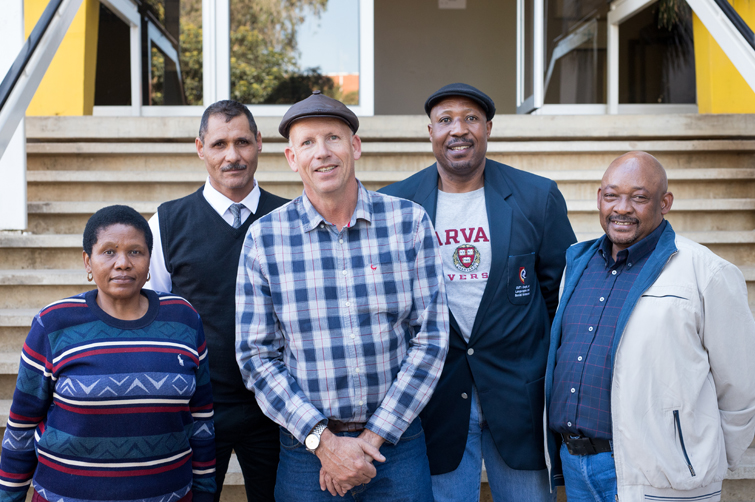Latest News Archive
Please select Category, Year, and then Month to display items
13 January 2020
|
Story Eugene Seegers
|
Photo Anja Aucamp
 Spearheading the digital expansion of the conversational Sesotho course is IDEAS Lab Director, Johann Möller (middle). With him are from the left: Prof Pule Phindane, CUT; Dr Brenton Fredericks, CUT; Bahedile Letlala, UFS Department of African Languages; and Dr Elias Malete, UFS Department of African Languages.
Spearheading the digital expansion of the conversational Sesotho course is IDEAS Lab Director, Johann Möller (middle). With him are from the left: Prof Pule Phindane, CUT; Dr Brenton Fredericks, CUT; Bahedile Letlala, UFS Department of African Languages; and Dr Elias Malete, UFS Department of African Languages.
For many years now, the UFS has been offering a one-year course in conversational Sesotho for staff members; this can then be followed up with the one-year course in advanced conversational Sesotho. The conversational Sesotho for students in the Faculty of Education was introduced in 2018 at the UFS.
The Central University of Technology (CUT) needed a conversational course for its first-year students and approached the Department of African Languages for the development of such a course. Living as we do in a multilingual country; this additional language skill opens doors and often hearts as well.
Using instructional design principles
However, the need was identified by both CUT and UFS to present this crucial information in a way that would be more appealing to digital natives as well as to those less familiar with technology. The Department of African Languages on the UFS Bloemfontein Campus, together with relevant departments from the CUT, approached the IDEAS Lab located on the UFS South Campus, since they already have a reputation for being a specialist on broadcasting and repackaging curricular content for digital presentations. The IDEAS Lab provided technical advice and built the multimedia programme, which will help the user to hear and practice phrases in Sesotho, using instructional design principles. The course will be available to both staff and students belonging to the two universities.
Room for growth
Johann Möller, Director of the IDEAS Lab, says this pilot programme will give both institutions the opportunity to test the use of multimedia for language acquisition. He adds, “Language is extremely complex, and we would like to expand this learning aid in the future.” In fact, the original design has room for growth built into it.
To keep things simple for the user and the building team, it was decided to start out with only four potential everyday scenarios where a staff member would like to speak Sesotho: Firstly, how to greet other persons from different genders; secondly, potential scenarios one might encounter in the university environment itself; thirdly, how to deal with situations at a hospital; and finally, how to use one’s language skills at a filling station.
Pronunciation is key
Each scenario contains three to four conversations that the learner can revise, along with images and audio that illustrate the situation and assist with correct pronunciation. The system does not allow the user to progress unless they have listened to the pronunciations of the sample sentences or phrases.
Further reading material and vocabulary lists are also provided, with the result that people who are using the programme can learn at their own pace. The authoring software Articulate Storyline was used to build the individual scenarios and each conversation or lesson within it. The lessons are also not dependent on an internet connection; they can be downloaded onto a flash memory drive and used offline.
Community engagement must be a core function of universities
2009-05-21
 |
Members of the NatCEMF Steering Committee are, from the left: Mr Jerome Slamat, Senior Director: Community Interaction, Stellenbosch University, Ms Beatrix Bouwman, Manager: Community Engagement, North-West University, Rev Kiepie Jaftha, Chief Director: Community Service, UFS and chairperson of the committee, Prof. Allan Femi Lana, Director: Institute for Rural Development and Community Engagement, Mangosuthu University of Technology, Prof. Seth Pollack, Fulbright Scholar, University of Western Cape (guest speaker at the meeting), Prof. Denver Hendricks, Director: Community Engagement, University of Pretoria, and Prof. Priscilla Daniels, Chairperson: Human Ecology and Research and CHESP Research Coordinator, University of the Western Cape.
Photo: Lacea Loader |
|
It is important that all tertiary institutions in South Africa should work together and commit themselves to advance the cause of community engagement in the country.
This was one of the main outcomes of the second meeting held by the National Community Engagement Manager’s Forum (NatCEMF) at the South Campus of the University of the Free State (UFS) in Bloemfontein recently. The meeting was attended by 34 representatives of 16 higher education institutions in the country.
“I am astounded at the interest in this matter. The representatives are committed to make community engagement a core function of their institutions and we all agreed that we should get more involved in expanding this across all institutions. A need for a formal structure for us all to work together and have a more collective voice was also identified,” said Rev Kiepie Jaftha, Chief Director: Community Service at the UFS and Chairperson of the NatCEMF Steering Committee.
“There is a growing need to expand and develop our engagement with communities – to share our experiences and best practices and to learn from each other. There are universities that are doing excellent work in this field and, by having a formal structure, we can do a lot more towards advancing community engagement,” said Rev Jaftha.
The meeting identified matters such as the coordination of higher education institutions’ involvement in community engagement, the facilitation of research about community engagement, promoting service learning as transformation, the establishment of a community engagement resource centre and the organisation of a national community engagement conference as some of its aims. A national steering committee was also elected. |